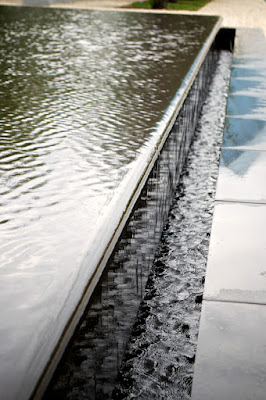John and I and our friend Nancy made our second visit to the Aga Khan Museum and Park yesterday.
On our last visit it was winter, the reflecting pools were empty and the garden trees and plants were bare. So we were thrilled to see the park with trees in leaf, the flowers in bloom and the pools full of water.
On our last visit it was winter, the reflecting pools were empty and the garden trees and plants were bare. So we were thrilled to see the park with trees in leaf, the flowers in bloom and the pools full of water.
We began our visit with a tour of the gardens. We had an engaging and knowledgeable guide.
We started at the front of the museum facing the Ismaili Center and the reflective pool. The Center was designed by Charles Correa and the gardens by Vladimir Djurovic.
The north garden room was bordered by wild roses. The designers have favoured native plants including Service Berry trees for the central courtyard.
Here we're facing the Aga Khan Museum which was designed by Fumihiko Maki. Our guide described the reflective pools which are made of black granite and quite shallow
and make a lovely splash as they flow gently over the edges of the pool.
The last two winters have been harsh in Toronto and many of the trees, shrubs and conifers have been damaged. Last winter's ice storm hurt one of the redwoods planted beside the Center. Won't they look wonderful in a hundred years!
The crystalline roof of the Prayer Hall in the Center in its bed of purple-flowering Russian Sage.
The view of the Museum and park from the Aga Khan's personal viewing porch near his office on the roof of the Ismaili Center. Lovely!
After our tour of the new garden we made a quick visit to the superb permanent collection of His Highness' Museum.
John loved this Shi'ite Standard or 'Alam. The tag says it is probably Deccan, and made of pierced metal, from 17th century Hindustan.
I of course wanted to see new illustrations and calligraphy. I loved this Muraqqa', which translates as a "patched together" album in book form that juxtaposed calligraphy, drawing, sketches and paintings.
This is Rustam Killing the Dragon. Attributed to Sadegi, Tabriz, Iran, ca 1576.
How about this demon escaping from a Persian palace
or this Dish with a Portrait of a Court Lady, Iran, 1620-40. The Aga Khan's collection is exquisite.
When we left the museum a light rain added reflections to the marble patio. We look forward to visiting often over the years and watching the park mature.


















Thank you for another lovely and interesting garden and museum tour. You always find the most marvelous items to showcase.
ReplyDeleteCheri
Thanks Cheri! We did have fun!
ReplyDeleteHaven't made the trip up there, but it sure looks worth it.
ReplyDelete